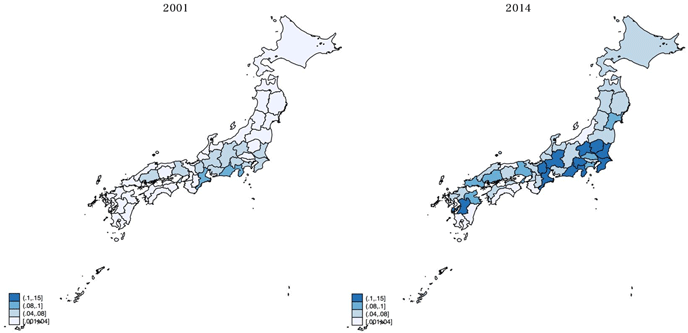| Author Name | Timothy DESTEFANO (OECD) / HANEDA Sho (Nihon University) / KWON Hyeog Ug (Faculty Fellow, RIETI) |
|---|---|
| Research Project | East Asian Industrial Productivity |
| Download / Links |
This Non Technical Summary does not constitute part of the above-captioned Discussion Paper but has been prepared for the purpose of providing a bold outline of the paper, based on findings from the analysis for the paper and focusing primarily on their implications for policy. For details of the analysis, read the captioned Discussion Paper. Views expressed in this Non Technical Summary are solely those of the individual author(s), and do not necessarily represent the views of the Research Institute of Economy, Trade and Industry (RIETI).
Raising Industrial and Firm Productivity (FY2016-FY2019)
East Asian Industrial Productivity
Firms in a dynamic market are continuously under pressure to adjust and evolve over time. The ability of firms to adapt to these competitive and technological factors can influence their growth trajectory. One of the ways in which firms have attempted to overcome these imbalances is through mass layoffs (Silva et al 2019). Another mechanism that a business can use to adjust is by substituting away from regular full-time employment to non-regular workers. Both methods can result in adverse effects to labor market participants. However, mass layoffs in Japan are rare. The typical feature of Japan's labor market since the 1970s has been lifetime employment, promotion through seniority and the participation of company unions. After the macroeconomic shock of 1992, many firms found that their labor structures were no longer efficient and needed reform (Kambayashi 2017). In response, a considerably number of Japanese firms adjusted their employee composition away from regular full-time employees towards non-regular workers.
Understanding the determinants of employee composition as a mechanism for structural adjustment is relevant to policy makers. The objective of this paper is to assess the evolution of employment use for Japanese manufacturers and identify the main determinants of this form of structural change. The paper starts by assessing descriptive analysis on the evolution of employment composition across years, industries and regions. While the use of haken workers has increased overtime, Figure 1 further demonstrates that these trends have been experienced across most of Japan. At the same time, certain regions appear to use haken employees more intensively than others. Prefectures in the Kanto and Kansai region as well as Kinki region use these types of employees more intensively than say in the Tohoku and Shikoku prefectures. Some of the determinants explaining regional concentration of employment types are due to spatial factors but may also be industrial composition and firm characteristics.

[Click to enlarge]
Source: Census of Manufacturers, calculations by authors.
Econometric techniques are used to identify how various plant and sector characteristics explain the employment of certain types of workers. Since worker composition is also influenced by the manner in which certain employees are fired, the analysis also examines the relationship between plant/sector characteristics and the dismissal of different types of workers. The econometric evidence identifies a number of countervailing factors, which influence the use of employment types. In terms of technology change, growth in the diffusion of robotics is linked to the employment of fewer non-regular employees. This appears to be partially driven by the fact that these machines are also related to the dismissal of certain types of non-regular workers. This fact can be explained by the discussion on a substitutability between Artificial Intelligence (AI) or robotics and labor, especially non-regular employments. Firm productivity is also an important determinant for the types of employees used. Increases in plant productivity leads to greater numbers of regular and non-regular workers in absolute numbers, but a greater proportion of regular workers. These results may suggest that more productive firms may be using certain types of non-regular worker as a flexible form of labor as a cost buffer in the event of a macro shock. It should be stated that there is a need for further discussion in respect of assistance in re-education and social safety net for a possible increase in unemployment of non-regular workers due to the diffusion of AI and robotics. Furthermore, training in a corporation is needed to change the employment contract from non-regular worker to regular worker, especially for firms and sectors that heavily depend on non-regular employments. For the future work, linking plants to firms within the Census of Manufacture would allow researchers to more fully understand how employees are being reallocated across plants within a firm overtime.
- Reference(s)
-
- Kambayashi, R. (2017), “Seiki No Sekai Hiseki No Sekai”, Keio University Press (in Japanese).
- Silva, F., Menon, C., Falco, P. and MacDonald, D. (2019), "Structural adjustment, mass lay-offs and employment reallocation", OECD Science, Technology and Industry Policy Papers, No. 72, OECD Publishing, Paris,
https://doi.org/10.1787/90b572f3-en.

